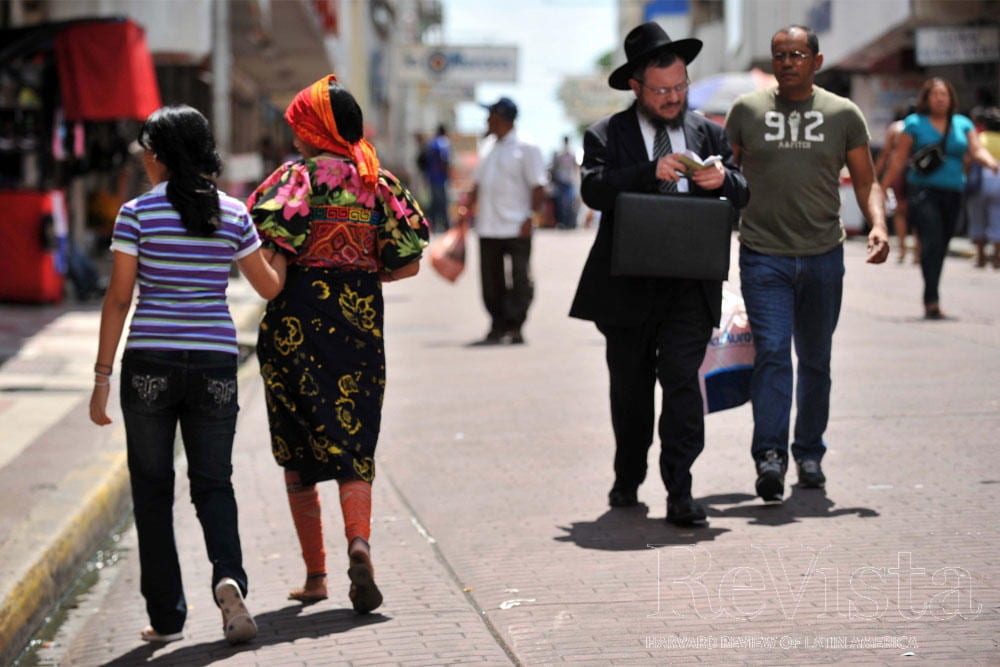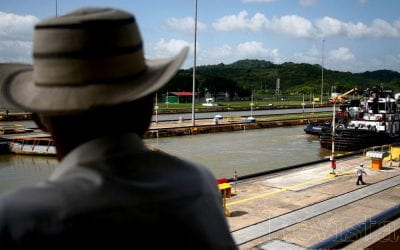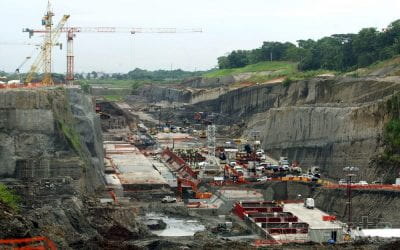Muslims and Jews in Panamá
Building Communities Through Commerce

Joint investments among Jews and Arab businessmen are common. Photo courtesy of La Prensa/Eduardo Grimaldo.
The Muslim community in Panamá, understood as a group that maintains its cultural and religious traditions, became rooted in the second half of the 20th century. It includes very distinct groups: Indian Muslims (my own ancestry); Arab immigrants from Lebanon; and Muslims of Palestinian and Jordanian origin.
These three communities are active predominantly in commerce, where they have been known to interact extensively and in good fashion. This peaceful coexistence and interaction extend well beyond the confines of the Muslim community. They apply as well to the two most successful business ethnic groups in Panamá, the Jewish and Arab communities, whose trading and commercial activities in many cases intersect. Both Jewish and Hindu employers once provided goods and services to Arab businessmen in Colombia. Then these Arab businessmen settled in the Colón Free Zone during the late ’60s in order to manage their own business transactions.
Frequent joint investments among Jewish and Arab businessmen in the financial, commercial or services sector are a legacy of the ancient Silk Road that marked trade activity between Europe and Asia—which helps explain the harmony and respect between these groups.
Muslims have migrated to Panamá for centuries, but a defined Muslim community is more recent. In the early 1900s, some immigrants of Arab origin came to Panamá, but they mingled with the Panamanian population and lost their religious identity.
Establishing a community requires the presence of women and children. The early Muslim immigrants arrived alone and failed to start families with religious unity. They intermarried; which is why many Christian families have Muslim last names such as Purcait, Sayyed, Hassan, Shaik, Ali or Malek.
The first wave of immigration from the Indian subcontinent occurred when Bengali Muslims reached Panamanian shores in the 1920s. Unlike migrants to Trinidad and Tobago, Guyana, and Suriname, who left Calcutta and Madras as a result of the British Empire’s Indentured Labor Laws dating from 1837, the Bengalis who came to Panamá did speak English as their primary language and worked mainly as street vendors. Other Muslim Indians trickled in circa 1925-30, for the most part Punjabis, Bengalis, and Gujaratis.
My grandfather was among those early Gujaratis. He immigrated to Panamá in 1929, following his brother Ismail Asvat who, after seeing a flyer in Bombay advertising Brazil, jumped onto a ship and sailed across the Indian and the Atlantic oceans. From Brazil, he sailed on to the Caribbean and then Panamá. Before his arrival, the only Indian immigrants in Panamá were the Bengali Muslims and one or two Pashtuns from what is today Pakistan.
It was not until the 1950s that my parents came to Panamá. This is also the period in our history when Muslim women—mostly from the south of Gujarat—began immigrating. Thus the majority of Muslim Panamanians today come from this western state of India, followed closely by a substantial Muslim community in Colón, mostly of Lebanese descent, later joined by Palestinians and Jordanians, who began to form a community in the early 90s.
As more and more Indian Muslims came to Panamá, several organizations sought to bring them together. According to the Public Registry, the oldest association was Misión Islam, established in 1946, that brought together the Bengali Muslims and some West Indians. The Association of Indian and Pakistani Muslims of Panama was formed in the 50s to meet the religious needs of the community—the establishment of a place of worship (especially for religious festivals such as Eid ul Fitr and Eid ul Adha), adequate burial facilities according to Islamic rules, and religious instruction to children. In 1975 it was renamed the Sunni Muslim Religious Association of Panamá, and it is still active today.
Today, immigrants from Gujarat and neighboring Sindh, now in Pakistan—communities that have been pioneers of trade for centuries in India, Africa and the Middle East—stand out in the Panamanian commercial sector.
The second largest Muslim community in Panamá, in the city of Colón, is predominantly composed of Arab immigrants from Lebanon. Lebanese businessmen had immigrated in significant numbers to West Africa, Brazil, Chile, El Salvador, Honduras and Colombia. Many of these Lebanese Muslim traders who marketed products in Colombia began to establish businesses in the Colón Free Zone in the second half of the 60s. This prosperous and well-respected community built a mosque, an Arab country club and a school in that city and the Islamic Cultural Center of Colón in 1981.
The third Muslim community, of Palestinian and Jordanian origin, is scattered throughout the country, with mosques and religious centers in Penonome, Changuinola, Chitre, Santiago and David.
Panamá’s Jews are drawn predominantly from the Middle East, where Aleppo was a key player in the Silk Road. The Arabs arrived mostly from Lebanon, a country that has seen significant emigration of businessmen to West Africa, Brazil, Chile, El Salvador, Honduras and Panamá.
Paralleling the tradition of the Silk Road, these groups of migrants to Panamá (Indian Muslims, Arab Muslims, and Middle Eastern Jews) share common commercial aspirations that have transcended their religious and cultural differences. After the 1989 American invasion of Panamá to overthrow Manuel Noriega’s dictatorship, chaos reigned in the city of Colón for a few days because of a lack of police units. Members of the Arab community took it upon themselves to safeguard the shops and warehouses owned by Jews and Hindus from plunder and pillage.
Brutally divisive events—the formation of the State of Israel and the partition of India—have threatened peaceful coexistence between Muslims and Jews in the Middle East and Muslims and Hindus in South Asia. In Panamá, nevertheless, powerful interests and opportunities sustain the collaborative relationship among these different ethnic/religious groups.
Rather, in the New World, these three groups share equal footing, disarming tensions created by the tumultuous events of the last century in the Indian Subcontinent and the Middle East. They have not wanted to move the political conflicts of their homelands to Panamá. In an intensely interconnected age, threats to this status quo could come from external sources. But for now, the Silk Road tradition is alive and well in Panamá.
Spring 2013, Volume XII, Number 3
Ebrahim Asvat, a Panamanian by birth, is a lawyer who received a Master’s in Law from Harvard Law School. He taught international law at the Universidad Santa María La Antigua for twelve years. He was director of the Panamanian National Police from 1990-91 after the fall of Noriega. He was president of the newspapers La Estrella de Panamá and El Siglo from 2001-2011.
Related Articles
A Tale of Two Flags
A Tale of Two Flags The Last Hurdle When in 1995 President Ernesto Pérez Balladares appointed me to head the commission responsible for the transition of the Panama Canal from U.S. to Panamanian hands, it never crossed my mind that yet another negotiation—unexpected...
Who Remembers Panamá?
There was a time, many decades ago, when the Isthmian country of Panamá—dividing the Americas—made near daily headlines from Canada to Argentina…
The Story That Panamá Decided to Write
A few days prior to the date set for the transfer of the Panama Canal from the United States to Panamá, a reporter from a U.S. news network asked me, “Mr…




